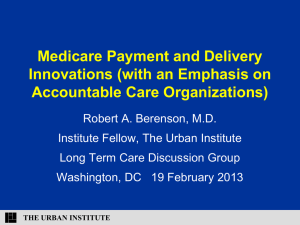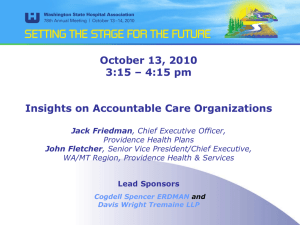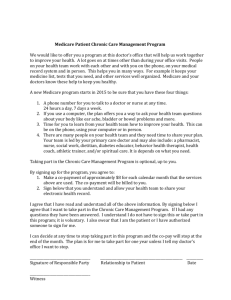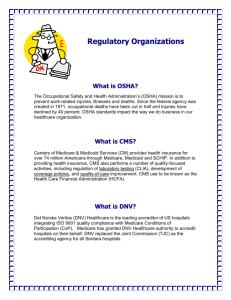THE URBAN INSTITUTE
advertisement
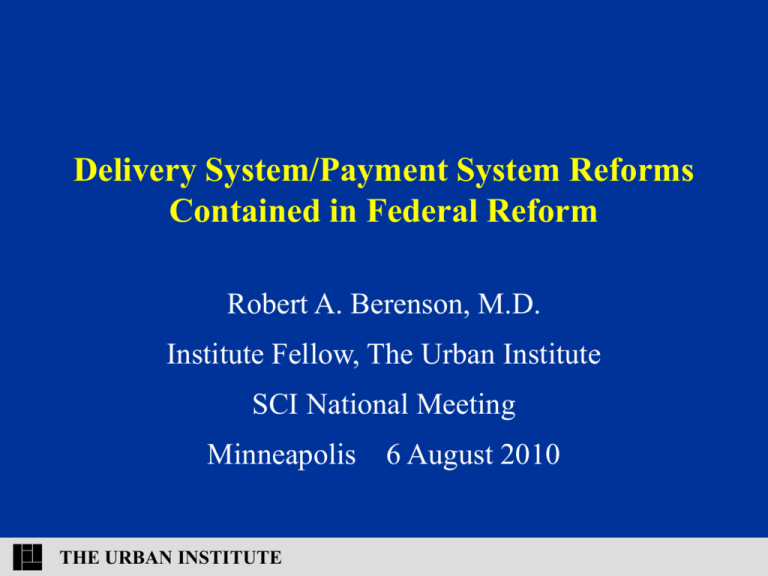
Delivery System/Payment System Reforms Contained in Federal Reform Robert A. Berenson, M.D. Institute Fellow, The Urban Institute SCI National Meeting Minneapolis 6 August 2010 THE URBAN INSTITUTE The Presentation Will Review: Some challenges that the delivery system and payment policy face Pros and cons of different payment models Overview of payment and organizational reform models in ACA What is an accountable care organization anyway? THE URBAN INSTITUTE Percent of People with Inpatient Hospital Stays Hospitalizations by Number of Chronic Conditions 50% 40% 32% 30% 22% 17% 20% 12% 10% 8% 4% 0% 0 1 2 3 4 Number of Chronic Conditions Source: G. Anderson, “Hospitals and Chronic Care”, PowerPoint Presentation to the American Hospital Association. Partnership for Solutions. 16 June 2004.; MEPS 2000. THE URBAN INSTITUTE 5+ Annual Prescriptions by Number of Chronic Conditions 49.2 Average Annual Prescriptions* 50 33.3 40 24.1 30 17.9 20 10 10.4 3.7 0 0 1 2 3 4 Number of Chronic Conditions *Includes Refills Sources: Partnership for Solutions, “Multiple Chronic Conditions: Complications in Care and Treatment,” May 2002; MEPS, 1996. THE URBAN INSTITUTE 5 Utilization of Physician Services by Number of Chronic Conditions 37.1 Unique Physicians Physician Visits 19.5 14.9 13.8 11.3 7.8 2.0 1.3 0 5.2 4.0 1 8.1 6.5 2 3 4 5+ Number of Chronic Conditions Sources: R. Berenson and J. Horvath, “The Clinical Characteristics of Medicare Beneficiaries and Implications for Medicare Reform,” prepared for the Partnership for Solutions, March, 2002; Medicare SAF 1999. THE URBAN INSTITUTE Medicare Spending Related to Chronic Conditions 20.3% 65.8% 11.3% 14.8% 16.3% 15.1% 22.1% Percent of Medicare Population 12.7% 10.3% 6.8% 3.5% 0.9% Percent of Medicare Spending Source: Partnership for Solutions, “Medicare: Cost and Prevalence of Chronic Conditions,” July 2002; Medicare Standard Analytic File, 1999. THE URBAN INSTITUTE 5+ Conditions 4 Conditions 3 Conditions 2 Conditions 1 Condition 0 Conditions Projected Total Medicaid Spending Per Enrollee $16,300 FY 2001 FY 2006 $11,200 $1,400 $2,000 $2,300 Children $17,200 $12,300 $3,200 Adults Disabled Elderly Note: Includes federal and state spending on benefits. Sources: J. Crowley and R. Elias. “Medicaid’s Role for People with Disabilities,” The Kaiser Commission on Medicaid and the Uninsured, August 2003; KCMU analysis based on CBO baseline for Jan. 02. THE URBAN INSTITUTE “The Tyranny of the Urgent” “Amidst the press of acutely ill patients, it is difficult for even the most motivated and elegantly trained providers to assure that patients receive the systematic assessments, preventive interventions, education, psychosocial support, and follow-up that they need.” (Wagner et al. Milbank Quarterly 1996:74:511.) THE URBAN INSTITUTE The Pressure of the 15 Minute Office Visit “Across the globe doctors are miserable because they feel like hamsters on a treadmill. They must run faster just to stand still…The result of the wheel going faster is not only a reduction in the quality of care but also a reduction in professional satisfaction and an increase in burnout among physicians.” (Morrison and Smith, BMJ 2000; 321:1541) THE URBAN INSTITUTE How Patients are Affected Asking patients to repeat back what the physician told them, half get it wrong. (Schillinger et al. Arch Intern Med 2003;163:83) Patients making an initial statement of their problem were interrupted by the PCP after an average of 23 seconds. In 23% of visits the physician did not ask the patient for her/his concerns at all. (Marvel et al. JAMA 1999; 281:283) THE URBAN INSTITUTE Incidents in the Past 12 Months Among persons with serious chronic conditions, how often has the following happened in the past 12 months? (Harris, Survey 2000) Sometimes or often 1. Been told about a possibly harmful drug interaction 54% 2. Sent for duplicate tests or 54% procedures 3. Received different diagnoses from different clinicians 52% 4. Received contradictory medical information 45% THE URBAN INSTITUTE The Issue of Readmissions In Medicare, about 11% of patients are readmitted within 15 days and almost 20% within 30 days 50% of patients hospitalized with CHF are readmitted within 90 days The majority of readmissions are potentially preventable – declining with time from index admission Half of those discharged to community and readmitted within 30 days after medical DRG had no interval bill for physician services THE URBAN INSTITUTE “There are many mechanisms for paying physicians, some are good and some are bad. The three worst are fee for service, capitation and salary.” -- Robinson, Milbank Q, 2001 THE URBAN INSTITUTE Distinguishing Between Payment to Groups and Payment to Physicians Within Groups Within physician organizations, 1/4 paid FFS, 1/4 paid by either capitation or pure salary, 1/2 on blends of retrospective and prospective methods – Robinson, Shortell, et al. HSR, Oct, 2004 Note that “salary with productivity incentives” usually means measures of productivity as defined by FFS payment parameters, either actual billings or RVUs generated -- may be counterproductive (pun intended) THE URBAN INSTITUTE The Basic Problem with Current FFS Payment to Clinicians The Resource Based Relative Value Scale (RBRVS)-based fee schedule has inherent limitations By design, the relative values of 7000+ codes are, at best, an approximation of underlying resource costs, not an attempt to determine what services beneficiaries need And, what purports to be an objective process is, despite many good intentions, inherently subjective Health reform legislation addresses the issue by calling for actual data to inform the CMS-RUC process, e.g. to determine actual time, not estimates, for work and otherwise focusing on potentially overvalued services THE URBAN INSTITUTE FFS for Primary Care Has Been Rooted in Face-to-Face Encounters There are plenty of reasons, e.g., – high transaction costs, associated with nonface-to-face, frequent, low dollar transactions; – major program integrity concerns – “moral hazard” driving expenditures Yet, increasingly, face-to-face visits do not encompass the work of primary/principal care for patients with chronic conditions (most Medicare beneficiaries and the duals) THE URBAN INSTITUTE Gaps in FFS Payments and the Patient-Centered Medical Home Current payment policies do not support the activities that comprise the Wagner Chronic Care Model: non-physician care, team conferences, coordinating care, community resources, patient registries, evidence-based practice guidelines, EMR The Patient-Centered Medical Home as a remedy? The House would have formally tested the community network medical home model, based on NC Medicaid, Vermont approaches Administration has committed to multi-payer demos called Advanced Primary Care – currently in process THE URBAN INSTITUTE Five Specific Payment Options (not mutually exclusive) Enhanced FFS payments for office visits Reimburse for new CPT services Regular FFS for office visits and small PPPM for medical home activities Reduced FFS for office visits and larger PPPM for medical home activities Comprehensive payment for medical services and medical home activities Can also provide startup/seed money for developing MH capacity THE URBAN INSTITUTE FFS Attributes Advantages – – – – Rewards activity, industriousness Theoretically can target to encourage desired behavior Implicitly does case-mix adjustment Commonly used by payers and physicians Disadvantages – – – – – Can produce too much activity, physician-induced demand Maintains fragmented care provided in silos High administrative and transaction costs What is not defined as reimbursable is marginalized Complexity makes it susceptible to gaming and to fraud THE URBAN INSTITUTE PPPM (Comprehensive or Global Payment) Advantages – – – – – Internalizes allocation of activity and costs to meet needs Direct incentive to restrain spending Predictable and capped spending Administratively simple (until address some of the problems) Low transaction costs Disadvantages – – – – – May lead to stinting on care Susceptible to cream-skimming Incentive to cost shift to services outside the PPPM Can’t specifically promote desired activity May resist innovation/ new services THE URBAN INSTITUTE Episode/Condition/Bundle/Case Advantages − internalizes incentives for efficiency within the episode − potentially aligns incentives across siloed providers − arguably, is an intermediate step on the way to real integration Disadvantages − does not fundamentally alter incentive to generate units of service − be careful about what you wish for, e.g. physician-hospital alignment without determination of appropriateness in a FFS environment − currently, political challenges in bundling among providers − technically challenging (esp. for ambulatory care) – vagaries of diagnosis (more episodes in Miami than Minnesota), bias to performance of a procedure in a case rate, sorting out where particular claims are assigned to THE URBAN INSTITUTE What is an Episode of a Chronic Disease, Such as Diabetes, CHF? An oxymoron. Would patients with 5 or more chronic conditions have 5 or more 365-day payment episodes? With payments to different clinicians/providers? To maintain any reasonably holistic approach to the patients with multiple chronic conditions, would need episodes of conditions that often cluster together, e.g. diabetes, hypertension, and renal failure But then why not go right to population-based payment, i.e., PPPM? THE URBAN INSTITUTE Public Reporting and Pay-forPerformance (P4P) Advantages – provides a hybrid payment to mitigate disadvantages of pure models; some natural blends – PPPM and under-service measures – can start to actually reward desired performance, instead of rewarding volume of services produced – can include measures of patient experience, which have been generally ignored in considerations of reformed payment approaches Disadvantages – underdeveloped measure set – especially for physicians – what gets measured gets done? – marginal incentives may be insufficient to counter basic incentives in whatever base model it is superimposed over – contributes more administrative complexity THE URBAN INSTITUTE Examples of Blended or Hybrid Payment Models PPPM with FFS carve outs or “bill aboves” and public reporting on underuse measures For PCMH, FFS for visits (possibly “discounted”), PPPM for medical home activities and P4P for patient experience Shared savings for ACOs Partial capitation – FFS/PPPM and/or risk corridors and/or particular sector (professional services, but not institutional) Any of the above with public reporting and/or pay-forperformance − quality measures where they exist, expenditure or utilization targets, patient experience measures THE URBAN INSTITUTE Key Payment Provisions HR3590 Patient Protection and Affordable Care Act and HR 4872 The Health Care and Education Reconciliation Act of 2010 THE URBAN INSTITUTE Payment Rate Changes Medicare Part A providers get reduced payment updates assuming economy-wide productivity increases. Physician fee schedule updates remains in the grips of the SGR nightmare, but there is greater authority for CMS to address mispriced services in the Fee Schedule Some providers are exempt from reach of new Independent Payment Advisory Board (IPAB) till 2019, e.g. hospitals, hospices, inpatient psych, etc. THE URBAN INSTITUTE Targeted Physician Payment Rate Changes In Medicare, 10% bonuses for primary care physicians (based on specialty designation and 60% of services are E&M) and for general surgeons in shortage areas In Medicaid, increased payments in FFS and managed care for primary care services (E&M and immunizations) to 100% of Medicare for 2013 and 2014, with 100% match, based on rates applicable on July 1, 2009. THE URBAN INSTITUTE Some “Value-based” Payment Provisions In Medicare, hospitals will receive incentive payments using the structure of the current Reporting Hospital Quality Data for Annual Program Update (RHQDAPU). To establish VBP standards to assess overall performance of each hospital – those with highest scores will receive highest extra payments – funded by reductions in DRG rates of 1-2% from FY13 to FY 17. PQRI expansion for physicians THE URBAN INSTITUTE Payment Adjustment for Conditions Acquired in Hospitals Based on current program for adjusting DRG payments for HACs, in FY 2015, hospitals in top quartile of risk-adjusted rates are to receive 99% of their payment Before then, performance reports are to be made public after hospitals review and correct THE URBAN INSTITUTE Medicaid Quality Measurement Program To establish priority for the development and advancement of quality measures for adults in Medicaid. Sets deadlines for development of measures, standardization of reporting formats and requires a report to Congress (2014 and every 3 years) Prohibits federal payments to states for Medicaid services for healthcare acquired conditions with regs to be effective 7/11 THE URBAN INSTITUTE Geographic Variation In Medicare and Other Payers The fallout from Dartmouth research and the food fight on the Hill pitting urban against rural and north and west against east and south The proposed Institute of Medicine Study of various dimensions of “value” – input price adjustments and geographic variations in resource use that was in the House bill did not survive. But one or both may take place under direction of the Secretary THE URBAN INSTITUTE Center for Medicare and Medicaid Innovation (CMI) within CMS Broad authority to test lots of new things – e.g. payment models, HIT, patient education, care for cancer patients, postacute care, chronic care management, telehealth, etc. Can adopt more broadly without going back to Congress if achieve certain positive outcomes on quality and/or cost THE URBAN INSTITUTE Innovation Center (cont.) Waives current budget neutrality requirement initially, but Secretary is supposed to terminate if either quality is not improved or spending reduced $10 billion available over 10 years (but concern about being “raided” for other purposes in a seriously underfunded agency) THE URBAN INSTITUTE Federal Coordinated Health Care Office (CHCO) Is designed to align Medicare and Medicaid financing, benefits, administration, oversight rules, and policies for dual eligibles Clarifies Medicaid demonstration authority for coordinating care for duals for up to 5 years THE URBAN INSTITUTE Medicare Shared Savings Program Narrow construct of the accountable care organization concept with language based on the Brookings model ▪ Real organizations, not “extended medical staffs” or other loose affiliations ▪ FFS with bonus for coming in under a spending target ▪ historical spending trended forward by projected national growth in A and B, adjusted for risk ▪ beneficiaries assigned (without their knowledge?) to an ACO THE URBAN INSTITUTE Global Payments and ACO Demonstrations in Medicaid and CHIP Global payment demo in up to 5 states for safety net hospitals – FY 2010-2012 ACO demonstrations in Medicaid and CHIP to allow pediatric medical providers – presumably pediatric hospital-based -organized as ACOs to participate in shared savings approach – 2012-2016 THE URBAN INSTITUTE National Pilot Program on Payment Bundling By 1/1/13, start to establish, test and evaluate alternative payment approaches for a 5-year, voluntary pilot for bundled episodes in Medicare – related to care provided around a hospitalization (3 days before to 30 days after). This one must be budget neutral Can include bids from entities (as in current ACEs -“acute care events” -- demo) Beneficiary can have one or more of 10 conditions to be identified THE URBAN INSTITUTE Medicaid Bundled Payment Demo For up to 8 states for acute and post-acute care – 2012 -- 2016 THE URBAN INSTITUTE “Independence at Home” Demonstration Program For 1/1/12, geriatric home visiting care model demo using shared savings approach Note that the target population is that served by Home and Community-Based Waivers – frail elderly, including duals at home, who may or may not be “homebound” under Medicare definition. THE URBAN INSTITUTE Hospital Readmissions Reduction Program Starting 10/1/12, adjustments in Medicare payments for hospitals with “excess readmissions” for 3 NQF approved conditions: AMI, pneumonia, CHF, with prospects for expansion to other conditions Readmission information to be made publically available after hospitals review and corrections THE URBAN INSTITUTE Community-based Care Transitions Program Establishes a 5 year Transitions Program starting 1/1/11. Funds hospitals with high readmissions rates and certain community-based organizations that provide transition services to high-risk beneficiaries. Applicants required to propose a specific care transition intervention other than discharge planning. Working with AoA and funded at $500 million THE URBAN INSTITUTE Some Other Medicaid Delivery and Payment Changes States get a 1% increase in FMAP for preventive services graded at A or B by US Preventive Services Task Force Coverage for smoking cessation for pregnant women with no cost-sharing Requires coverage for free standing birth center services Medicaid kids can get hospice concurrent with other care $100 million in grant funding for states to set up programs for Medicaid benes – tobacco cessation, weight control, lower cholesterol and BP, diabetes THE URBAN INSTITUTE Medical Homes and Accountable Care Organizations THE URBAN INSTITUTE The ACA Medical Home Provision Creates a Medicaid state option to implement a test of a “health home” – focus on beneficiaries with at least 2 chronic conditions (one and at risk of another or one serious with persistent mental health condition) – set of activities is specified – chronic care management, health promotion, transition care, etc. $25 million planning grants with 90 percent FMAP for first 8 quarters for home health-related services THE URBAN INSTITUTE What is an ACO? In fact, there is little agreement Some see it as a virtual organization with providers assigned based on claims history Others emphasize that they are real organizations, typically identified as integrated delivery systems, with or without a hospital as part THE URBAN INSTITUTE Potential Real ACO Organizations Shortell and Casalino identified 5 types of current organizations that could be or be part of an ACO • • • • • Independent Practice Association Multispecialty Group Practice Hospital Medical Staff Organization Physician-Hospital Organization Organized or Integrated Delivery System THE URBAN INSTITUTE Three Essential Characteristics Ability to provide and manage with patients the continuum of care across different institutional settings, at the very least, ambulatory and inpatient care Capacity to prospectively set budgets and allocate resources Sufficient size to support comprehensive, valid, and reliable performance measurement THE URBAN INSTITUTE Is ACO Just a New Term for PSO (Provider Sponsored Organization)? In BBA 1997, PSOs were created to permit Medicare to engage in financial risk contracting directly with providers They built it and no one came – actually 3 in 10 years. THE URBAN INSTITUTE What is New? Greater flexibility in organizational models New payment models, no longer full capitation – e.g., FFS w. shared savings based on total spending and partial capitation Improved risk adjustment Availability of performance measures Prospect of ratcheting down on FFS rates Alternatives to a beneficiary hard lock-in THE URBAN INSTITUTE How Would an ACO Work for Purchasers and Commercial Plans? Well-founded concern about Medicare “sanctioned” ACOs developing and using market power in negotiations to drive prices higher Concern is they might reduce costs but not provide the savings to purchasers in reduced premiums THE URBAN INSTITUTE Section 3022 is Very Prescriptive Sets out requirements for real, not virtual organizations – IPAs, multispecialty group practices, PHOs, joint ventures between hospitals and physician entities Shared savings model – FFS with bonus if come in under a spending target – threshold for percentage saved before sharing and savings split to be decided in regs Accepts historical costs associated with patients assigned to ACO on the basis of claims patterns Beneficiaries may not know about assignment – and no limits on current freedom of choice THE URBAN INSTITUTE Section 3022 (cont.) Language permits CMS to test other payment methods including “partial capitation” Partial capitation can mean – mixed FFS and PPPM; capitation for part of total spending, e.g. Part B, not Part A – that seems to be the statutory intent; or capitation with corridors to limit losses and gains THE URBAN INSTITUTE Skeptics In many markets, physicians have drawn away from the hospital and function increasingly independently. Weak financial incentives may not be able to bring them together. (But in other markets hospitals are employing physicians – for better or worse) Jeff Goldsmith on Health Affairs blog – “The problem with this movie is that we’ve actually seen it before and it was a colossal and expensive failure.” THE URBAN INSTITUTE

